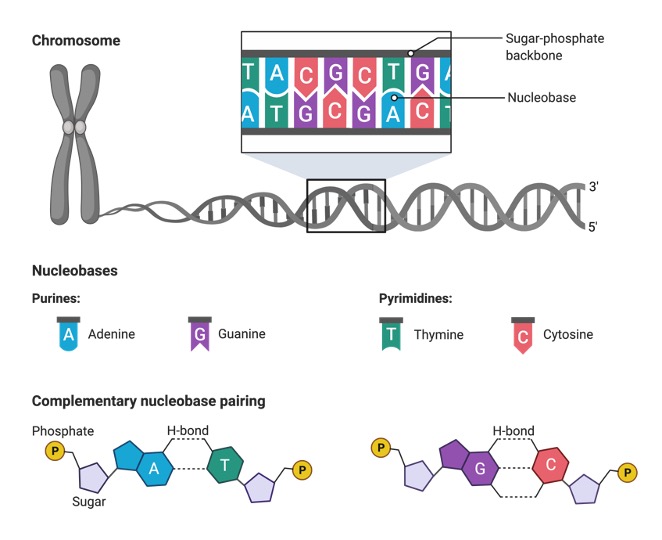Table of Contents
Nucleic Acid Definition
Nucleic Acid is any of a class of complex molecules made up of linear chains of monomeric nucleotides, each of which is made up of phosphoric acid, sugar, and a nitrogenous base and in every living cell, which are essential in the preservation, replication, and expression of genetic information.
What is Nucleic Acid?
Any molecule generated by living creatures is referred to as a biomolecule. As a result, the vast majority of them are organic compounds. Amino acids and proteins, carbohydrates (particularly polysaccharides), lipids, and nucleic acids are the four primary categories of biomolecules.

Any of the group of complex substances made up of linear chains of monomeric nucleotides is referred to as a nucleic acid. Phosphoric acid, sugar, and nitrogenous base make up each nucleotide component in turn. Hereditary information is preserved, replicated, and expressed with the help of nucleic acids. Deoxyribonucleic acid (DNA) and ribonucleic acid (RNA) are the two primary kinds of nucleic acids (RNA).
Nucleic Acid History and Terminology
Friedrich Miescher (1844–1895), a Swiss physician and scientist, is credited with discovering nucleic acids in 1868. From the nuclei of white blood cells, he was able to extract a biological substance that was neither a protein, carbohydrate, or lipid. He called the compound nuclein for the place where he got it.
Albrecht Kossel (1853–1927), a German scientist, identified the compound’s acidic characteristics. He is also credited for discovering the nucleobases adenine, cytosine, guanine, thymine, and uracil for the first time.
Later, nuclein was substituted by nucleic acid, which was invented by German physician Richard Altmann (1852–1900) in 1889. Miescher’s found nuclein was subsequently recognised as DNA in particular. The molecular scientists James Watson (American) and Francis Crick (British) are credited with developing the double helix model of DNA in 1953.
Their double-helical model of DNA was primarily based on Rosalind Franklin’s 1920 – 1958 X-ray diffraction image (known as Photo 51) and Raymond Gosling’s 1952 X-ray diffraction image.
Nucleic Acid Structure
Nucleic acid is a biopolymer made up of monomeric nucleotide molecules. Phosphoric acid, sugar (5-carbon), and nitrogenous base make up each nucleotide that makes up a nucleic acid.

3′, 5′ phosphodiester linkages connect the nucleotide chains of a nucleic acid. This indicates that one nucleotide’s 5′-phosphoric group is esterified with the 3′-hydroxyl of the nucleotide next to it.
Nucleic Acid Types
DNA and RNA are the two main kinds of nucleic acids. DNA is a double-stranded nucleic acid that contains a living thing’s genetic information.

It is required for an organism’s cell development, division, and function. Except for certain viral RNAs and siRNA, which are double-stranded, RNA is a single-stranded nucleic acid.
Nucleic Acid Biology
The original (parent) strands of DNA in the double helix are separated and each one is replicated to generate a new (daughter) strand during DNA replication. Because one of each parent strand is preserved and remains intact after replication, this method is called semi-conservative.
DNA replication is aided by a number of enzymes, including DNA polymerases. Base pairing is used to replicate one of the parental strands of the DNA molecule so that the newly synthesised strand is complementary to the original or parent strand.
The purine nucleobase (adenine and guanine) is coupled with the pyrimidine nucleobase in this way (i.e. cytosine and thymine). Adenine will be coupled with thymine, whereas guanine will be linked with cytosine.
Cell division necessitates DNA replication. DNA is copied in the early stages of mitosis (prophase) and meiosis (prophase I) in preparation for the late phases of mitosis and meiosis, when the cell splits into two cells with identical copies of DNA.
Proofreading processes verify copies of DNA molecules after replication. DNA replication may be induced artificially using the polymerase chain reaction, a laboratory method that can amplify the target DNA fragment from the genome.
The genetic information that codes for a certain protein is carried by DNA. As a result, the genetic information for a protein is first copied into RNA during protein translation (specifically, mRNA). Transcription is the process of converting a copy of DNA into mRNA with the aid of the enzyme RNA polymerase.
Although RNA polymerase travels along the DNA template strand from 3′ to 5′, the reference point is generally the coding (non-template) strand. As a result, the process moves in the same 5′ to 3′ direction as DNA replication.
Transcription, unlike DNA replication, does not require a primer to begin and instead relies on base pairing to generate an RNA copy that contains uracil rather than thymine. In prokaryotes, transcription takes place in the cytoplasm, but in eukaryotes, transcription occurs predominantly in the nucleus before being transferred to the cytoplasm for translation or protein synthesis.
Purines, pyrimidines, phosphoric acid, and a pentose, either D-ribose or D-deoxyribose, are produced during the breakdown of nucleic acids.
Nucleic Acid Importance
The genetic information required for all cellular activities and inheritance is stored in nucleic acids. Metabolic problems and illnesses may result from mutations in the genetic code. Many of these diseases are caused by a seemingly functioning protein that is inadequately generated or has become dysfunctional as a result of a mutation in the gene(s) that code for it.
Because genes are handed down through generations, many metabolic abnormalities and illnesses are heritable. Mutations, on the other hand, are required in evolutionary terms. They improve living things’ variability, allowing them to better adapt to a changing environment.







